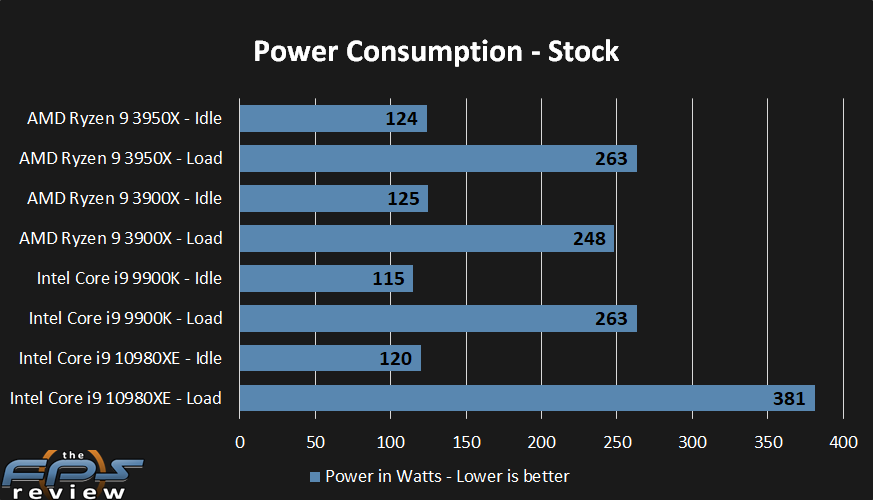Power Consumption
Our power consumption methodology is quick and dirty. It involves using a Kill-A-Watt device with only the test machine connected to it sans monitor and any external devices. The idle power is tested at the Windows desktop on a clean system while doing nothing but running background tasks. Load testing is done by using Cinebench R20 in a multi-threaded test. The power is then observed on the Kill-A-Watt instrument. These devices are not known for being super accurate, so this is a ballpark measurement. Cinebench R20 is largely used because it doesn’t utilize the GPU, which keeps the impact of the component to a minimum. All the systems we’ve tested from day one have been tested in this manner.

The Ryzen 9 3950X can consume a ton of power. It’s got 16 cores and reasonably high clock speeds, so this isn’t or shouldn’t be surprising. However, its rather efficient compared to something like Intel’s Core i9 10980XE, which at stock speeds uses almost 120w more power. We do see a very modest increase in power consumption over the 3900X. Given that both chips carry a 105w TDP, this makes sense when the systems are essentially idle and at base clocks or lower. When you ramp up their clock speeds beyond idle, the 3950X pulls slightly more power than the 3900X does. It’s likely that the 3950X is using some of the best Ryzen dies available and as a result, ends up being more efficient but still pulls in a bit more power due to higher core counts.

When overclocked, the power consumption of the 3950X is considerably higher than that of the 3900X. When idle, the 3950X’s power consumption while overclocked is basically identical to that of the 3900X. When under load, the power consumption increases to 346 watts. This is a massive amount of power consumption and the cooling requirements to do it increase substantially. An all core overclock of 4.3GHz as seen here is beyond the capability of any conventional air cooler. Interestingly, the Core i9 10980XE consumes a whopping 271 watts more than the Ryzen 9 3950X. You do get more performance in many instances with the 10980XE (as you’ll see later) but not enough to justify the cost and power consumption increases. You are getting two more cores, but at 14nm, the thing is just too much of a pig.
In this context, the Ryzen 9 3950X appears to be very efficient for the clocks and core count it has. Even so, one thing I’d like to point out is that you will need a motherboard with beefy VRM’s to handle this thing. Many of the budget B350 and B450 motherboards aren’t going to be up to the task. Even if they are “compatible”, you might see very poor boost clocks when seriously pushing the CPU. That would even be a best-case scenario for some motherboards. For the Ryzen 9 3950X, I’d generally recommend sticking to higher quality B450 options, but X470 and X570 alternatives would likely be better choices.
